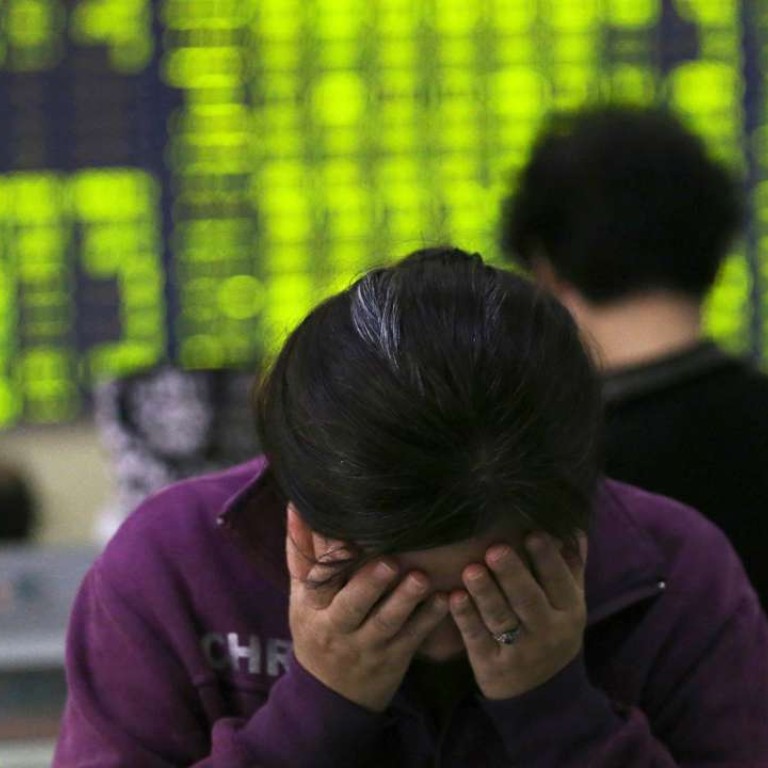
Even after crashing 42pc from last year’s peak, are Chinese markets still too frothy?
One of the most commonly used descriptions for current sentiment is ‘wait and see’, but analysts are already warning the bears are coming
There is a lingering question hanging over the mainland stock market: are A-shares, following a more than 40 per cent plunge from its high in 2015, still expensive?
The benchmark Shanghai Composite Index has been swinging in a relatively narrow range since March, ending at 2.994.3 on Thursday.
That’s 42 per cent shy of the close on June 12, 2015 when a stock market rout started, leaving millions of retail investors to carry the can.
The boom-to-bust cycle seriously hurt investor confidence and the China Securities Regulatory Commission (CSRC) made an all-out effort to stem further slides.
During the strong rally between October 2014 and June 2015, investors snubbed warnings about a potential bursting bubble as they went on a buying rampage, betting on further jumps.
Asset prices became detached from underlying intrinsic values and rose to unsustainable levels.
The market froth was clear for everyone to see.
In China, investors are usually motivated by herd mentality rather than fundamentals. Most are taking a wait-and-see attitude, amid flat trading
Fundamentals this year are expected to remain unchanged, with analysts predicting a zero annual growth in corporate earnings.
“In China, investors are usually motivated by herd mentality rather than fundamentals,” said Huaxi Securities analyst Wei Wei.
“Most are taking a wait-and-see attitude, amid flat trading.”
Since 1990 when the first stocks started trading on the Shanghai Stock Exchange, mainland investors have continued to keep their ears open for government policy direction, because they have always regarded it as a market orchestrated by the authorities.
Despite the 42 per cent discount to the frothy valuations of June last year, investors are still far from convinced the time is right to bargain hunt.
On the Shanghai exchange, companies generally trade at less than 15 times their 2015 earnings, which is believed to be a reasonable price level.
In the Shenzhen bourse, the price-to-earnings (P-E) multiple hits 49 on the SME board, and tops 73 on the Nasdaq-like ChiNext market.
Gao Ting, chief China strategist at UBS, says shares listed on the SME board and ChiNext market remain frothy, even after the sharp falls in the past year.
A-shares in companies dual-listed in the mainland and Hong Kong stock markets now trade at a more than a 27 per cent premium to their H-share counterparts.
UBS predicts the CSI300, the indicator tracking the mainland’s 300 largest listed companies, will hover around the 3,200-mark this year after assessing the overall economic fundamentals and corporate earnings outlook.
The CSI closed at 3,221.14 on Thursday.

Arguably more than any other market in the world, investors are prone to wild overreactions to rumours about policy changes.
On Wednesday, for instance, the ChiNext market slumped 5.5 per cent as speculation swirled about a possible regulatory curb being put on fund flows from banks’ wealth management products.
Gao from UBS says market sentiment and movement is also likely to react sharply to pessimistic views held by institutional and individual investors.
During the first week of this year, China suspended its new stock market circuit breaker for the Shanghai and Shenzhen stock exchanges, after the mechanism sparked sharp falls in the country’s volatile markets.
The breaker, in place since the start of the year, was designed to temper the market but instead caused a wave of selling.
Analysts and investors said the trigger levels were too low and too close to work effectively.
Beijing scrapped the system immediately after two trading suspensions triggered a crisis of confidence.
And analysts now say that dire scenario is still weighing on investors’ minds.
“Many investors are still reluctant to return to the market any time soon, after being battered, and still fear another bumpy ride,” Gao said.
There are also strong worries over the rising wave of defaults, as heavy industrial companies, especially coal miners and steel makers, saddled with overcapacity, continue to dim the market outlook.
The CSRC is now controlling the pace of initial public offerings to allay concerns about a fresh equity influx that could dilute existing holdings.
It appears any news or speculation can have a negative psychological impact on investors, and spark a wave of panic selling.
Analysts consider that if the Shanghai Composite Index was to crash below the 2,800-point level, we could enter a genuine bear market, with many more investors rushing to cash out.

